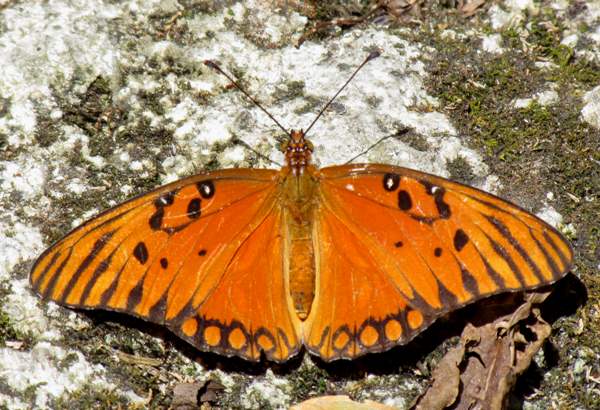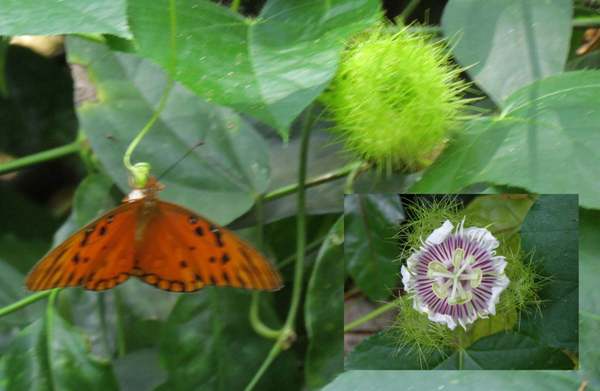Gulf Fritillary Butterfly - Agraulis vanillae
Phylum: Arthropoda - Class: Insecta - Order: Lepidoptera - Family: Nymphalidae

The Gulf Fritillary, more commonly referred to in the Caribbean as the Silver-spotted Flambeau, is widespread and relatively common in Barbados (where butterflies are far from plentiful). It is one of the few butterflies likely to be seen in flower gardens, where it comes to drink nectar. These long-winged butterflies are not close relatives of the true fritillaries (such as the Marsh Fritillary).
Distribution
The 'Gulf' in the common name that is used most often in the USA is a reference to the Gulf of Mexico, of course, and not the Arabian Gulf. This a mainly South-American and West Indies species, but it is also resident all-year round in Florida and Texas. The practice of planting Passionflowers in gardens is drawing it further north, even into central parts the USA during the warmer months of the year.
Although occasionally seen on forest paths, this is primarily a sun-loving butterfly, and sunlight certainly helps to show it off at its very best. The wingspan is usually between 6.5 and 8cm, and the upperside of wings and body is fiery orange; however, the undersides of the wings are buff with large silver spots. Males and females look very similar (to us, that is!) Key distinguishing features are two, or more often three, silvery-white spots ringed in black on each of the upper front forewings. (In the specimen shown here the third spot is entirely black.)
Lifecycle
The yellow eggs are laid singly on leaves or buds of the larval foodplants. Fully grown caterpilars are about 4cm long and bright orange with soft black spines that do not sting; however, the larvae feed mainly at night, and as a further defence mechanism they are toxic and so birds tend to avoid them.
Looking like a curled-up dead leaf hanging from a twig, the olive-brown marbled chrysalis has small silvery streaks along the dorsal edges of its wing cases.
The larval foodplants of this distinctive butterfly are Passionflowers, Passiflora species. In Barbados, where we photographed these butterflies, they were flitting among the beautiful (but supposedly stinky) Passiflora foetida (below).

Studying butterflies and moths...
Excited at the prospect of flyfishing? So are we, and we're pretty sure you would find the Winding River Mystery trilogy of action-packed thrillers gripping reading too. Dead Drift, Dead Cert, and Dead End are Pat O'Reilly's latest river-and-flyfishing based novels, and now they are available in ebook format. Full details on our website here...
Buy each book for just £4.96 on Amazon...
Please Help Us: If you have found this information interesting and useful, please consider helping to keep First Nature online by making a small donation towards the web hosting and internet costs.
Any donations over and above the essential running costs will help support the conservation work of Plantlife, the Rivers Trust and charitable botanic gardens - as do author royalties and publisher proceeds from books by Pat and Sue.
